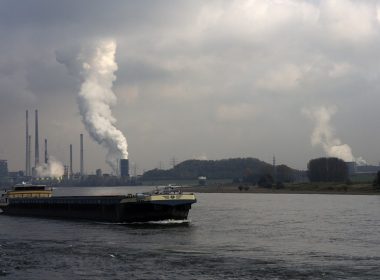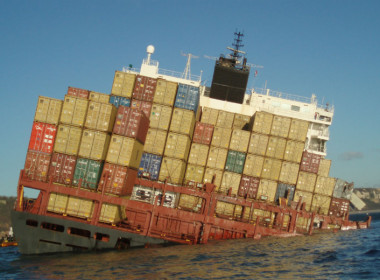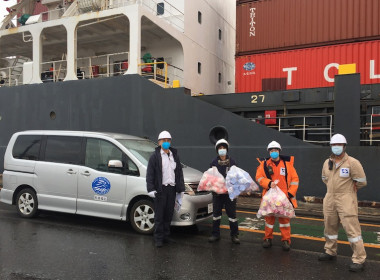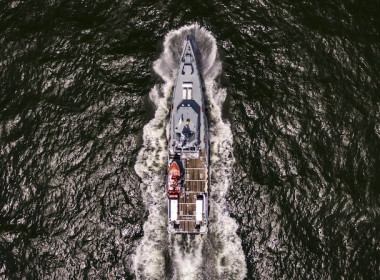COLUMN | The plight of the suffering seafarer [Grey Power]

Just occasionally, you see an image that makes you look twice and to ask questions about what the artist – or in this case the photographer – really might be portraying. There is such a photograph on the front cover of the latest Flying Angel News, which, as many will know, is the magazine published for supporters of the welfare charity Mission to Seafarers.
At first glance, the picture seems unremarkable. It shows a seafarer, probably the duty watchman, in his orange overalls, with his radio around his neck, near the bottom of the gangway of his ship. He is wearing working gear as well as his safety helmet and he appears to be just about to pick up a carrier bag with the mission’s logo upon it. The bag has been delivered to the ship by the chaplain, or ship visitors, one of whom, presumably, has taken the photograph.
One might think it is a pleasant encounter, with the bag containing gifts, or perhaps the delivery of some shopping, done by the local mission staff as part of its everlasting effort to make life more welcoming for the visiting ships’ crews. But if you think about it and look a bit more closely, there are other matters that might cause you to pause in your quick assumptions. For a start, the gangway is not obviously landed on the quay, and the seafarer is crouched down, peering under the rail, as he speaks to the mission staff some feet beneath him. He is wearing a double mask, over which his tired eyes might be distinguished. The bag of “goodies” has been placed on the gangway, “socially distanced” between those on the land and the individual on the ship, and the inference is that this is the closest they will ever be to one another.
“Against this appearance of technical normality, those aboard ships were effectively non-persons who had to be isolated lest their presence contaminate the shore-side population.”
The seafarer, and all those aboard the ship, will be unable to take those few steps to land on terra firma, while no visitors, no matter how welcome they might be and legitimate their mission, will be permitted to board the ship.
We know nothing about the identity of the seafarer, the name of his ship, and the port in which this friendly encounter took place, but we might assume that this will be one of the many places where Covid-19 restrictions have not gone away and the lives of seafarers, aboard the ships upon which everyone ashore depends, remain impacted.
And this has been reality for so many seafarers since the pandemic first emerged to blight all our lives more than three long years ago. As someone who only neglected to go ashore in a port where there was no reason to do so, I cannot imagine the sheer misery of long ocean voyages aboard thinly crewed ships, where there would be no relief of a few hours on dry land. The ships came and went, the cargo was discharged and loaded, but against this appearance of technical normality, those aboard were effectively non-persons, aliens who had to be isolated lest their presence contaminate the shore-side population.
Al least in the picture, the welfare agencies have been permitted into the port, to deliver their parcels – at the height of the emergency, such an arm’s length encounter would have been completely prohibited by the powers that be in so many places. We remember the really awful cases – the ship’s company forced to sail with dead shipmates for months on end, the refusal of medical aid for sick seafarers who should be in hospital, the convenient buck-passing that went on between the authorities, with the human needs aboard a ship ignored or passed off to the next port of call. We remember the difficulties of repatriation, the often illogical quarantine rules invoked, which made it virtually impossible to change crews and which brilliant people in crewing and ship agencies worked miracles to address.
“Hopefully, authorities might publicly acknowledge society’s debt to the world’s seafarers who, despite their grim treatment, kept the ships running and the desperately needed goods flowing into the shops.”
However, it is sad to learn that there are still ports in the world where shore leave remains off-limits, either because of residual Covid problems, or more worryingly, because local jobsworths think it would be a good idea to maintain the restrictions “because they can”. You would like to think that eventually, what was once normality might return.
But as in many countries, where there is a more forensic scrutiny of what happened during the pandemic and what we can learn from the various strategies, the authorities might include their treatment of visiting ships in their analysis of what was done right and wrong. Hopefully, they might publicly acknowledge society’s debt to the world’s seafarers who, despite their grim treatment, kept the ships running and the desperately needed goods flowing into the shops.
We might also consider in our vote of thanks the welfare agencies who, despite every obstacle in their way, offered friendship and consolation to the beleaguered seafaring population, exemplified by the image of that unknown man on the gangway.







